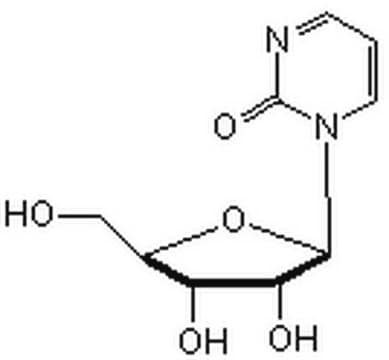Yes it is soluble in DMSO. In the publication "Cancer Res., 61, 6331-6334 (2001)" by A. Chetcuti et al., there are further details on the preparation of a 5 micromolar working concentration from a 5 Molar freshly prepared stock solution in DMSO.
A2385
5-Azacytidine
≥98% (HPLC), powder, DNA methyltransferase inhibitor
Synonym(s):
5-Azacitidine, 4-Amino-1-(β-D-ribofuranosyl)-1,3,5-triazin-2(1H)-one, Ladakamycin
Select a Size
About This Item
Recommended Products
Product Name
5-Azacytidine, ≥98% (HPLC)
Quality Level
Assay
≥98% (HPLC)
form
powder
mp
226-232 °C (dec.) (lit.)
antibiotic activity spectrum
viruses
Mode of action
DNA synthesis | interferes
originator
Celgene
storage temp.
−20°C
SMILES string
NC1=NC(=O)N(C=N1)[C@@H]2O[C@H](CO)[C@@H](O)[C@H]2O
InChI
1S/C8H12N4O5/c9-7-10-2-12(8(16)11-7)6-5(15)4(14)3(1-13)17-6/h2-6,13-15H,1H2,(H2,9,11,16)/t3-,4-,5-,6-/m1/s1
InChI key
NMUSYJAQQFHJEW-KVTDHHQDSA-N
Gene Information
human ... DNMT1(1786) , DNMT3A(1788) , DNMT3B(1789)
Looking for similar products? Visit Product Comparison Guide
General description
Application
- for cell induction[2]
- to study its effects on bovine fetal mesenchymal stem cells (bfMSC)[3]
- to study its effects on human bone marrow stromal cells (hBMSCs)[4]
- to study its effects on and DNA methyltransferase 1 (DNMT1) and Ras protein activator like 1 (RASAL1) expression[5]
- to interfere with DNA methylation and histone acetylation[6]
- to determine its effects on the conversion of control fibroblasts[7]
- for optical coherence tomography (OCT) and fluorescein angiography (FA)[8]
- for the reactivation of Sal-like protein (SALL)3 expression[9]
Biochem/physiol Actions
Features and Benefits
Signal Word
Danger
Hazard Statements
Precautionary Statements
Hazard Classifications
Acute Tox. 4 Oral - Aquatic Chronic 1 - Carc. 1A - Muta. 2 - Repr. 1B - STOT RE 1
Storage Class Code
6.1C - Combustible acute toxic Cat.3 / toxic compounds or compounds which causing chronic effects
WGK
WGK 3
Personal Protective Equipment
Choose from one of the most recent versions:
Already Own This Product?
Find documentation for the products that you have recently purchased in the Document Library.
Customers Also Viewed
Articles
Cancer research has revealed that the classical model of carcinogenesis, a three step process consisting of initiation, promotion, and progression, is not complete.
We offer a variety of small molecule research tools, such as transcription factor modulators, inhibitors of chromatin modifying enzymes, and agonists/antagonists for target identification and validation in gene regulation research; a selection of these research tools is shown below.
-
Is Product A2385 soluble in DMSO?
1 answer-
Helpful?
-
-
I just need to perform a purity assay on Product No. A2385 (5-Azacytidine). What would you recommend?
1 answer-
We assay the purity of this product by HPLC. If you would like to obtain a copy of our HPLC parameters/method, please contact your local Sigma-Aldrich Technical Service group.
Helpful?
-
-
What is Product No. A2385 (5-Azacytidine) used for?
1 answer-
This nucleoside analog has been used variously as an antitumor agent and as a mutagenic agent.
Helpful?
-
-
What is the solution stability of Product No. A2385? That is, how should I store solutions of 5-Azacytidine?
1 answer-
We generally don't recommend storing solutions, since it has such poor solution stability. In Cancer Res., 61, 6331-6334 (2001), A. Chetcuti et al. describe preparing a 5 micromolar working concentration from a 5 Molar freshly prepared stock solution in DMSO.
Helpful?
-
-
What is the Department of Transportation shipping information for this product?
1 answer-
Transportation information can be found in Section 14 of the product's (M)SDS.To access the shipping information for this material, use the link on the product detail page for the product.
Helpful?
-
-
I need to perform an identity test on Product No. A2385 (5-Azacytidine). What would you recommend?
1 answer-
This means that each lot is tested according to the list of tests (left hand column), and must meet or exceed the specifications (right hand column). HPLC. The elemental analyses for carbon and nitrogen content are identity tests (albeit not absolutely conclusive identity tests). I would say that the HPLC, using a previous lot of A2385 as a control sample, provides the best evidence for identity and purity.
Helpful?
-
Active Filters
Our team of scientists has experience in all areas of research including Life Science, Material Science, Chemical Synthesis, Chromatography, Analytical and many others.
Contact Technical Service












![Imidazo[1,2-a]pyridine-7-carboxylic acid AldrichCPR](/deepweb/assets/sigmaaldrich/product/structures/307/298/b27c0495-0260-443a-9af3-d106cfb691a6/640/b27c0495-0260-443a-9af3-d106cfb691a6.png)

